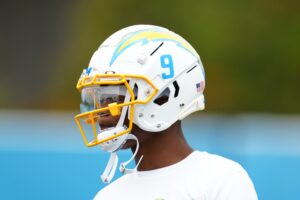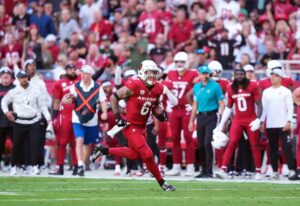The New England Patriots surprised everyone when they opted not to take a tight end during the 2019 NFL Draft. While nobody could ever replace Rob Gronkowski, the common perception was that the Patriots would add at least one body to the depth chart. However, New England stayed true to their draft board and didn’t reach for undeserving players. That said, the Patriots could still use an influx of talent. If the Patriots are looking to upgrade the depth chart, they could look to trade for Minnesota Vikings tight end Kyle Rudolph.
Breaking Down a New England Patriots, Kyle Rudolph Trade
If acquired, Kyle Rudolph would probably be the top tight end on New England’s depth chart. While Austin Seferian-Jenkins has upside, Rudolph has been the more consistent player throughout his career. Since entering the league back in 2011, Rudolph has accumulated 386 receptions for 3,787 yards and 47 touchdowns. He can still catch the ball, as evidenced by his 64 receptions for 634 yards and four touchdowns in 2018.
Rudolph’s 2018 statistics are somewhat inflated by one fantastic outing. Rudolph went wild in Week 16 against the Detroit Lions, recording nine receptions for 122 yards and two touchdowns. When taking out that game, Rudolph only had two games with more than 60 yards and five receptions.
Rudolph isn’t anything special as a blocker, but he’s capable of lining up inside and holding his own against linebackers. New England is one of the most run-heavy offenses in the league, and blocking is a major part of the job description. While he’s not a dominant blocker a la Rob Gronkowski or Dwayne Allen, he’ll ultimately help the running game as an in-line blocker.
Basically, Rudolph is a solid, if unspectacular, starting tight end who can hold down a top tight end spot. He obviously won’t be nearly as good as Gronkowski, but he’s capable of playing at a Daniel Graham level. The question now becomes whether it’s worth New England’s efforts to bring Rudolph aboard.
New England’s Current Depth Chart
There’s a real argument to be made that tight end is the weakest part of New England’s roster. Austin Seferian-Jenkins currently tops the depth chart, which isn’t a good thing. While the former second-round pick boasts some athletic upside, he’s unlikely to reach it. Jenkins has only eclipsed 21 receptions and 350 yards once in his career. While he graded out as a good blocker in 2018, that performance was something of an outlier.
Behind him on the depth chart are Matt LaCosse, Ryan Izzo, Stephen Anderson, and Andrew Beck. Anderson and Beck both have some pass-catching experience, but both leave a lot to be desired. Anderson recorded 36 receptions for 435 yards and two touchdowns with the Houston Texans while Beck recorded 28 receptions for 281 yards and two touchdowns last season with the Texas Longhorns.
LaCosse and Izzo, meanwhile, are battling it out for the blocking tight end role. Izzo has yet to play a professional snap but reportedly impressed coaches during training camp and the preseason. 2018’s seventh-round pick could have taken Dwayne Allen’s job last season were it not for his injury. LaCosse, meanwhile, spent the 2018 season with the Denver Broncos and finished the year as the 53rd-ranked tight end, per Pro Football Focus.
Obviously, this ragtag group of tight ends could certainly use an upgrade. Kyle Rudolph would improve the position, but does Rudolph’s ability justify his price tag?
Rudolph’s Price Tag
Kyle Rudolph is in the final year of his contract and carries a $7.625 million cap hit, per Spotrac. This is the fifth-highest cap hit among tight ends, and Rudolph is not the fifth-best tight end in the league. The Patriots are notorious for not paying top dollar to average players, and trading for Rudolph would certainly deviate from their typical financial decisions. Additionally, the Patriots are projected to have just $10,656,064 in cap space after they sign their draft picks, according to @patscap. Trading for Rudolph would leave New England with just $3.03 million in cap space, which is obviously not ideal.
The good news is that none of Rudolph’s 2018 salary is guaranteed. According to Spotrac, Rudolph has a $100,000 workout bonus and a $250,000 roster bonus. If the Patriots traded Rudolph and he didn’t make the Week One roster, they wouldn’t take any notable dead money.
The Minnesota Vikings currently have one of the worst salary cap situations in the league. Per Spotrac, the Vikings have just $1.77 million in cap space and still need to sign their entire draft class. For what it’s worth, Minnesota already appears to be planning for life without Rudolph, as they selected Alabama’s Irv Smith Jr. in the second round of the 2019 NFL Draft.
The Patriots could probably get Rudolph for a late-round conditional pick, and they’re in prime position to make that type of a move. New England is currently scheduled to have 14 picks in the 2019 NFL Draft, including seven in the final two rounds. The Patriots could easily part with one of those late-round picks in exchange for Rudolph. If it works out, New England could sign him to an extension to lower his 2019 cap hit. If it doesn’t, the Patriots can cut him before the start of the season with no effect on the salary cap. This is a low-risk, medium-reward move which the Patriots should consider pursuing.
Main photo:
Embed from Getty Images






